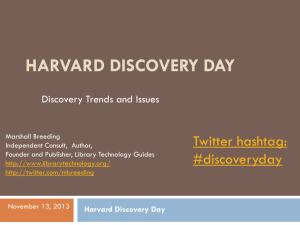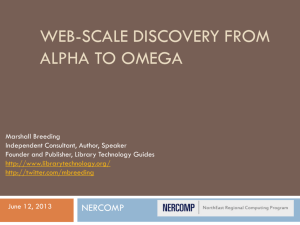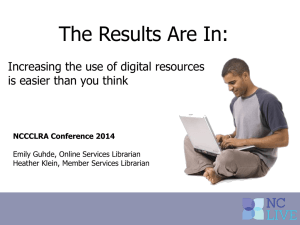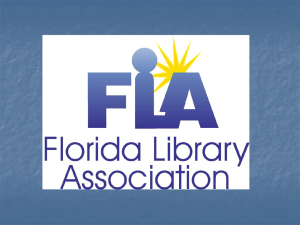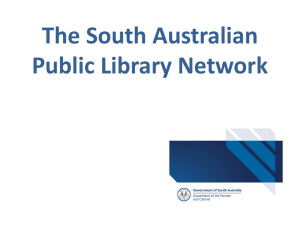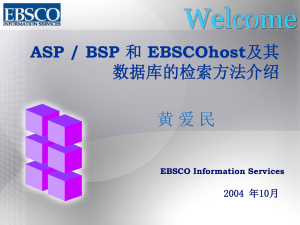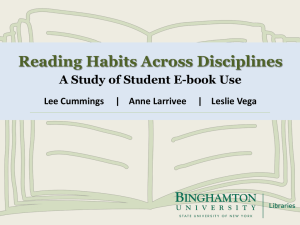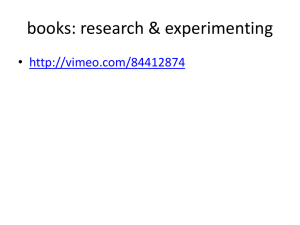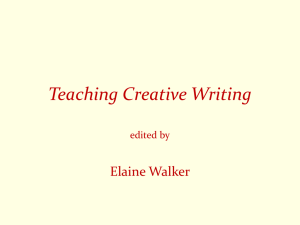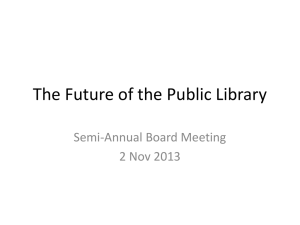Discovery Services for Libraries
advertisement
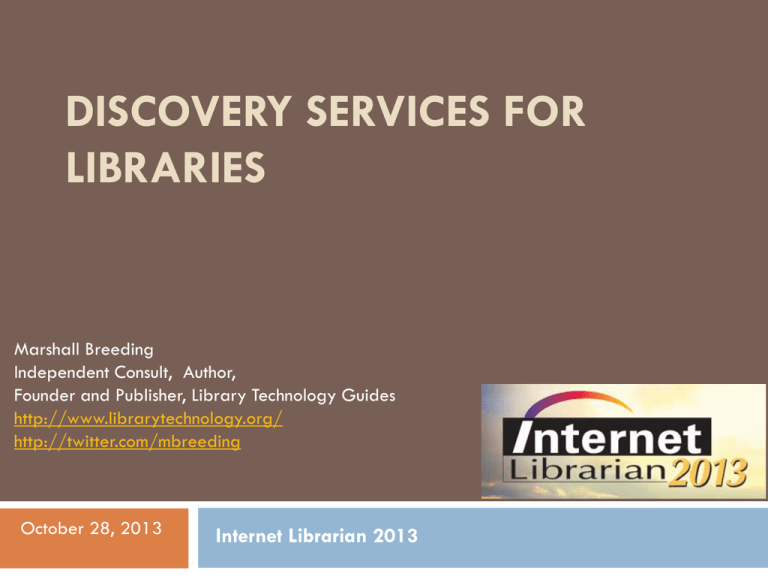
DISCOVERY SERVICES FOR LIBRARIES Marshall Breeding Independent Consult, Author, Founder and Publisher, Library Technology Guides http://www.librarytechnology.org/ http://twitter.com/mbreeding October 28, 2013 Internet Librarian 2013 Summary The realm of technologies helping libraries provide access to their collections and services through their web presence continues to evolve and innovate. Indexbased, or “web-scale” discovery services have become a mainstay in academic libraries in helping their users find the materials they need among the vast resources available to them. Socially oriented discovery interfaces and portal products help public and other libraries bring together a variety of service and content offerings. Breeding gives an update on the realm of these public-facing technology products and services and takes a look into the trends going forward. Discovery Resources Discovery on LTG The Evolution of Library Resource Discovery Discovery in ARL Libraries http://www.librarytechnology.org/arl-discovery.pl Online Catalog ILS Data Search: Scope of Search Search Results Books, Journals, and Media at the Title Level Not in scope: Articles Book Chapters Digital objects Next-gen Catalogs or Discovery Interface Single search box Query tools Did you mean Type-ahead Relevance ranked results Faceted navigation Enhanced visual displays Cover art Summaries, reviews, Recommendation services Scope of Search Books, Journals, and Media at the Title Level Other local and open access content Not in scope: Articles Book Chapters Digital objects Discovery Interface search model Search: Local Index ILS Data Digital Collections ProQuest Search Results MetaSearch Engine EBSCOhost … MLA Bibliography ABC-CLIO Real-time query and responses Discovery from Local to Web-scale Initial products focused on interface improvements AquaBrowser, Endeca, Primo, Encore, VuFind, Civica Sorcer, Axiell Arena Mostly locally-installed software Current phase is focused on pre-populated indexes that aim to deliver Web-scale discovery Primo Central (Ex Libris) Summon (Serials Solutions) WorldCat Local (OCLC) EBSCO Discovery Service (EBSCO) Encore ES (+EDS Index) Public Library Information Portal ILS Data Digital Collections Search: Usagegenerated Data Customer Profile Consolidated Index Search Results Web Site Content Community Information Aggregated Content packages … Customerprovided content Reference Sources Archives Pre-built harvesting and indexing Discovery services as Website Replacement Portal environment that includes customized content management service that can fulfill typical offerings on library Web sites Full integration between Web site and resource discovery (ideally) Examples: Axiell Arena Infor Iguana Web-scale Index-based Discovery (2009- present) Digital Collections Search: Customer Profile Consolidated Index Search Results Usagegenerated Data ILS Data Web Site Content Institutional Repositories Aggregated Content packages … Open Access E-Journals Reference Sources Pre-built harvesting and indexing Web-scale Search Problem ILS Data Digital Collections Search Results Consolidated Index Search: Web Site Content Institutional Repositories Aggregated Content packages … E-Journals ??? Problem in how to deal with resources not provided to ingest into consolidated index Pre-built harvesting and indexing Non Participating Content Sources Expanding the Depth of Discovery Citations / Metadata > Full Text Citations or structured metadata provide key data to power search & retrieval and faceted navigation Indexing Full-text of content amplifies access Important to understand depth indexing Currency, dates covered, full-text or citation Many other factors Full-text Book indexing HathiTrust: 11 million volumes, 5.3 million titles, 263,000 serial titles, 3.5 billion pages HathiTrust in Discovery Indexes Primo Central (Jan 20, 2012) [previously indexed only metadata] EBSCO Discovery Service (Sept 8 2011) WorldCat Local (Sept 7, 2011) Summon (Mar 28, 2011) Challenge for Relevancy Technically feasible to index hundreds of millions or billions of records through Lucene or SOLR Difficult to order records in ways that make sense Many fairly equivalent candidates returned for any given query Must rely on use-based and social factors to improve relevancy rankings Objectivity: Does relevancy reflect bias or publisher preferences Challenges for Collection Coverage To work effectively, discovery services need to cover comprehensively the body of content represented in library collections What about publishers that do not participate? Is content indexed at the citation or full-text level? What are the restrictions for non-authenticated users? How can libraries understand the differences in coverage among competing services? Evaluating the Coverage of Indexbased Discovery Services Intense competition: how well the index covers the body of scholarly content stands as a key differentiator Difficult to evaluate based on numbers of items indexed alone. Important to ascertain now your library’s content packages are represented by the discovery service. Important to know what items are indexed by citation and which are full text Important to know whether the discovery service favors the content of any given publisher Non-Cooperative Scenarios Two major players are both publishers and discovery service providers EBSCO – ProQuest ProQuest does not provide content to other discovery services EBSCO does not provide content to other discovery services Issue currently being pressed by Orbis Cascade Alliance. Open Discovery Initiative NISO Work Group to Develop Standards and Recommended Practices for Library Discovery Services Based on Indexed Search Informal meeting called at ALA Annual 2011 Co-Chaired by Marshall Breeding and Jenny Walker Term: Dec 2011 – Dec 2013 Balance of Constituents 23 Libraries Marshall Breeding, Vanderbilt University Jamene Brooks-Kieffer, Kansas State University Laura Morse, Harvard University Ken Varnum, University of Michigan Sara Brownmiller, University of Oregon Lucy Harrison, College Center for Library Automation (D2D liaison/observer) Michele Newberry Publishers Lettie Conrad, SAGE Publications Roger Schonfeld, ITHAKA/JSTOR/Portico Jeff Lang, Thomson Reuters Linda Beebe, American Psychological Assoc Aaron Wood, Alexander Street Press Service Providers Jenny Walker, Ex Libris Group John Law, Serials Solutions Michael Gorrell, EBSCO Information Services David Lindahl, University of Rochester (XC) Jeff Penka, OCLC (D2D liaison/observer) ODI Project Goals: Identify … needs and requirements of the three stakeholder groups in this area of work. Create recommendations and tools to streamline the process by which information providers, discovery service providers, and librarians work together to better serve libraries and their users. Provide effective means for librarians to assess the level of participation by information providers in discovery services, to evaluate the breadth and depth of content indexed and the degree to which this content is made available to the user. ODI Timeline 25 Milestone Target Date Appointment of working group Dec 2011 Approval of charge and initial work plan Mar 2012 Agreement on process and tools Jun 2012 Completion of information gathering Jan 2013 Completion of initial draft Jun 2013 Completion of final draft Sep 2013 Public Review Period commences Sep 2013 Status Social Discovery A more social user experience Ratings, rankings, reviews Enhanced content Connections with the library Connections with other users Challenge: Must have critical mass of engagement to have an impact Social Strategies Inherent BiblioCommons: design and infrastructure created with social flavor and features Layered or integrated ChiliFresh: integrate a third party social platform into any given library catalog or discovery service Socially-powered discovery Leverage use data to increase effectiveness of discovery Usage data can identify important or popular materials to inform relevancy engines Identify related materials that may not otherwise be uncovered through keyword matching Be careful to avoid introducing bias loops E-Book Integration Critical concern for public libraries Most libraries offer e-book lending programs Strong demand: increasing use statistics Print lending remains vigorous Commercial library e-book lending services OverDrive 3M Cloud Library Baker & Taylor: Axis 360 “Douglas County Model” Locally curated e-book collections and lending platform E-book Lending Models Phase I: Link out to e-book lending service Phase II: Load MARC records in local catalog, then link out on individual titles Phase III: Discovery and lending operations performed fully within the library’s catalog or discovery environment Full e-book lending Discovery of print and e-book titles and copies simultaneously E-book transactions represented within patron’s library account List of charged items, due dates Service options: renew, return, etc. Ability to check-out and download e-books into ereader Library Interfaces with e-book Integration Polaris PowerPAC BiblioCommons SirsiDynix eResource Central Innovative Interfaces: Encore ES TLC: LS2 PAC OdiloTK from OdiloTID The e-book integration ecosystem E-book lending services must expose APIs Online catalog or discovery services must consume APIs and adjust interface design and business logic to accommodate discovery and lending operations Challenge: each e-book service provider’s APIs are different Response: Work toward consistent or standard suite of APIs Library Technology Reports The Current State of Library Resource Discovery Products: Context, Library Perspectives, and Vendor Positions In press for Publication January 2014 LTR Components Vender questionnaire Library Survey Industry announcements Other articles and publications Library Discovery Survey Survey executed to gather data from libraries regarding their experiences with discovery services Responses received by 396 Libraries: 29 Countries represented, 252 responses from United States Academic 247 Consortium Government Agency Law Medical Museum National Other Public Special State Theology 15 2 7 5 1 1 1 96 14 4 3 Overall Satisfaction Overall Effectiveness Comprehensiveness: Academic Libraries Relevancy Effectiveness Objectivity in Discovery Objectivity in Discovery: Academics Example Product rating chart Discovery Trends Discovery Service Installations Product 2007 2008 2009 2010 2011 2012 EBSCO EDS 5,000 Primo 12 AquaBrowser 55 339 Encore 72 LS2 PAC 37 Civica Sorcer Axiell Arena 53 506 111 101 64 69 74 72 109 56 72 46 58 88 Summon Enterprise Installed 77 58 1900 750 365 73 305 50 164 214 158 704 75 100 102 328 16 7 12 22 61 57 33 3 42 76 Trend Tendency toward re-alignment with management systems Alma + Primo / Primo Central Sierra + Encore WorldCat Local + WorldShare Management Services Intota + Summon Counter trend Many libraries continue separate discovery strategies Open source discovery + licensed Web-scale index EBSCO Discovery Service: strategy to integrate with any back-end ILS or LSP Trend Increased uptake in academic libraries of Web-scale discovery services Almost a “must-have” product as one component of overall resource discovery and dissemination strategy Trend Content providers cooperate with discovery service providers for indexing in Web-scale services New content partnerships continue to be announced Counter Trend A&I providers and aggregators less likely to participate Competitive issues Need to preserve the value of maintaining subscriptions Trend Public libraries moving back to discovery interface associated with their ILS ILS Online Catalog modules now offer most discovery interface characteristics Examples: Most libraries using Polaris ILS use Polaris PowerPAC catalog interface. Displacing AquaBrowser or Endeca TLC libraries have largely abandoned AquaBrowser for LS2 PAC Counter Trend BiblioCommons BiblioCommons is the primary discovery layer widely implemented in public libraries that continues to replace ILS online catalog modules Trend Increased universe of discovery through highly-shared infrastructure Built-in resource sharing by many libraries participating in shared automation environment Major Products Serials Solutions: Summon Launched in June 2009 First “web-scale” discovery service Unified search results, facets, etc Summon 2.0 released in 2013 Emphasis on tools to provide research assistance beyond search results Topic explorer, scholar profiles, database recommender, content spotlighting, etc Ex Libris: Primo / Primo Central Primo (discovery interface) launched in 2005 Deployed Primo Central: article-level index introduced in 2009 Index locally or cloud maintained by Ex Libris, cloud hosted Scholar Rank: technology designed to order search results according to scholarly importance EBSCO Discovery Service Extends EBSCOhost platform with non-EBSCO content Users comfortable with EBSCOhost interface will easily adapt to EDS Platform Blending Direct delivery of full-text from EBSCO sources Linking to full text for non-EBSCO content http://www.ebscohost.com/discovery WorldCat Local Statistics from OCLC web site: 952+ million articles with one-click access to full text 38+ million digital items from trusted sources like Google Books, OAIster and HathiTrust 14+ million eBooks from leading aggregators and publishers 48+ million pieces of evaluative content (Tables of Contents, cover art, summaries, etc.) included at no additional charge 232+ million books in libraries worldwide http://www.oclc.org/worldcat-local.en.html Innovative Interfaces: Encore Initial version: discovery interface only with local index Encore Synergy: XML Web services interfaces to resource targets for articles Encore / EDS integration: agreement with EBSCO to integrate EDS for mutual subscribers BiblioCommons: BiblioCore Discovery service oriented to public libraries Social features – share reading lists, etc E-book discovery and lending integration Full replacement for online catalog Pooling of patrons across participating library organizations Blacklight Open source discovery interface Originated at the University of Virginia Increasing interest by academic libraries Stanford, Columbia, Cornell, etc No open access article-level index VuFind Open source discovery interface Originally developed at Villanova University Widely deployed Web-scale indexes integrated by subscribers through APIs No open access article-level index Axiell: Arena Comprehensive library portal Discovery + Web site features Positioned as discovery interface for Axiell’s several ILS products Discovery layer for Archival products: CALM and Adlib Can front both Library and Archival or museum products simultaneously: CultereNet Infor: Iguana Comprehensive library portal Discovery + Web site features Widget based architecture Positioned as marketing and communications portal Replaces both online catalog and Web site Catalog 2.0 Edited by Sally Chambers Chapter: “Nextgeneration discovery: an overview of the European scene” Library Technology Report: 2007 Introduction to nextgeneration library catalogs or discovery interfaces Trends Profiles of major products Next-Gen Library Catalogs Marshall Breeding Neal-Schuman Publishers March 2010 Volume 1 of The Tech Set Questions and discussion
